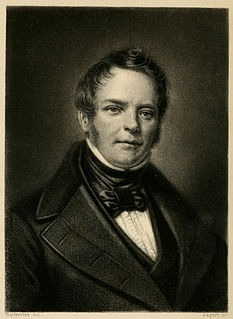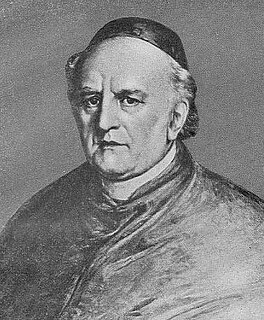Related Research Articles

Johan Nicolai Madvig, was a Danish philologist and Kultus Minister.

Karl or Carl Gottlob Zumpt was a German classical scholar known for his work in the field of Latin philology.

Dionysius of Halicarnassus was a Greek historian and teacher of rhetoric, who flourished during the reign of Augustus Caesar. His literary style was atticistic – imitating Classical Attic Greek in its prime.

Angelo Mai was an Italian Cardinal and philologist. He won a European reputation for publishing for the first time a series of previously unknown ancient texts. These he was able to discover and publish, first while in charge of the Ambrosian Library in Milan and then in the same role at the Vatican Library. The texts were often in parchment manuscripts that had been washed off and reused; he was able to read the lower text using chemicals. In particular he was able to locate a substantial portion of the much sought-after De republica of Cicero and the complete works of Virgilius Maro Grammaticus.
Lucius Annaeus Cornutus, a Stoic philosopher, flourished in the reign of Nero, when his house in Rome was a school of philosophy.

Giles of Rome O.S.A., was a Medieval philosopher and Scholastic theologian and a friar of the Order of St Augustine, who was also appointed to the positions of Prior General of his Order and as Archbishop of Bourges. He is famed as being a logician, producing a commentary on the Organon by Aristotle, and for his authorship of two important works, De Ecclesiastica Potestate, a major text of early 14th century Papalism, and De Regimine Principum, a guide book for Christian temporal leadership. Giles was styled Doctor Fundatissimus by Pope Benedict XIV.
Marcus Verrius Flaccus was a Roman grammarian and teacher who flourished under Augustus and Tiberius.
Gregory Bar Hebraeus, known by his Syriac ancestral surname as Bar Ebraya or Bar Ebroyo, and also by a Latinized name Abulpharagius, was a Maphrian of the Syriac Orthodox Church from 1264 to 1286. He was a prominent writer, who created various works in the fields of Christian theology, philosophy, history, linguistics, and poetry. For his contributions to the development of Syriac literature, has been praised as one of the most learned and versatile writers among Syriac Orthodox Christians.

Emil Osann was a German physician and physiologist from Weimar. He was a founder of scientific balneology.
Quintus Asconius Pedianus was a Roman historian.
Flavius Caper was a Latin grammarian who flourished during the 2nd century AD.

De re publica is a dialogue on Roman politics by Cicero, written in six books between 54 and 51 BC. The work does not survive in a complete state, and large parts are missing. The surviving sections derive from excerpts preserved in later works and from an incomplete palimpsest uncovered in 1819. Cicero uses the work to explain Roman constitutional theory. Written in imitation of Plato's Republic, it takes the form of a Socratic dialogue in which Scipio Aemilianus takes the role of a wise old man.

Assistens Cemetery in Copenhagen, Denmark, is the burial site of many Danish notables as well as an important greenspace in the Nørrebro district. Inaugurated in 1760, it was originally a burial site for the poor laid out to relieve the crowded graveyards inside the walled city, but during the Golden Age in the first half of the 19th century it became fashionable and many leading figures of the epoch, such as Hans Christian Andersen, Søren Kierkegaard, Christoffer Wilhelm Eckersberg, and Christen Købke are all buried here.
Johannes de Garlandia or John of Garland was a medieval grammarian and university teacher. His dates of birth and death are unknown, but he probably lived from about 1190 to about 1270.
An ars grammatica is a generic or proper title for surveys of Latin grammar. The first ars grammatica seems to have been composed by Remmius Palaemon, but is now lost. The most famous ars grammatica since late antiquity has been that composed by Donatus.
The gens Appuleia, occasionally written Apuleia, was a plebeian family at ancient Rome, which flourished from the fifth century BC into imperial times. The first of the gens to achieve importance was Lucius Appuleius, tribune of the plebs in 391 BC.
Mar Timothy II was Patriarch of the Church of the East from 1318 to c. 1332. He became leader of the church at a time of profound external stress due to loss of favor with the Mongol rulers of Persia.
Giovanni Tortellli, also known as Tortellius was a Renaissance humanist, largely responsible for the creation of the Vatican Library, together with scholars such as Bessarion and Poggio Bracciolini.
Theodosius of Alexandria was an Ancient Greek grammarian, purported to have lived about the time of Constantine the Great. A terminus ante quem is yielded by a letter of Synesius to the "wonderful grammarian Theodosuis". Theodosius himself cited Apollonius Dyscolus and Herodian in his works.
Friedrich Gotthilf Osann was a German classical philologist. He was a brother to physician Emil Osann (1787–1842) and chemist Gottfried Osann (1796–1866). He received his education at the Universities of Jena and Berlin, where he was a student of August Boeckh. In 1816 he obtained his PhD, and during the following year undertook an educational journey through Germany, France, Italy and England. In 1821 he was appointed an associate professor of philology at Jena, followed by a full professorship at the University of Giessen in 1825.
References
- ↑ Angelo Mai, Juris Civilis Ante-Justinianei Reliquiae, &c, Rome, 1823
- ↑ Friedrich Gotthilf Osann, Darmstadt, 1826
- ↑ Johan Nicolai Madvig, de Apuleii Fragm. de Orthogr., Hafniae, 1829
![]() This article incorporates text from a publication now in the public domain : Smith, William (1870). "Appuleius, Caecilicus Minutianus Appuleius". In Smith, William (ed.). Dictionary of Greek and Roman Biography and Mythology . Vol. 1. p. 251.
This article incorporates text from a publication now in the public domain : Smith, William (1870). "Appuleius, Caecilicus Minutianus Appuleius". In Smith, William (ed.). Dictionary of Greek and Roman Biography and Mythology . Vol. 1. p. 251.